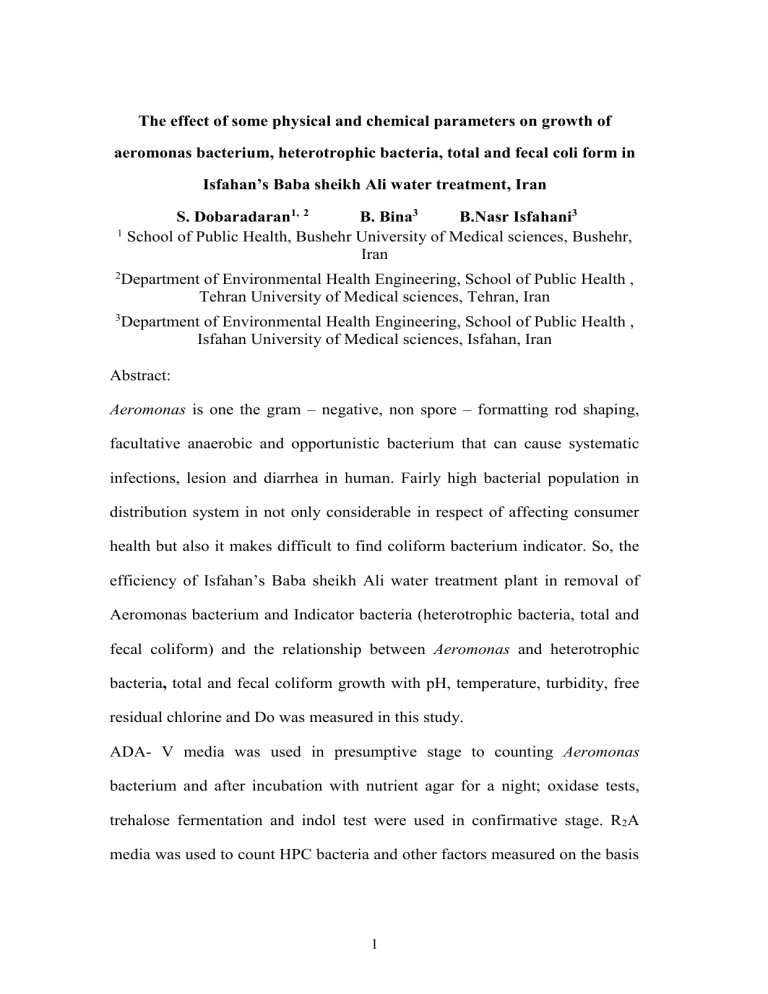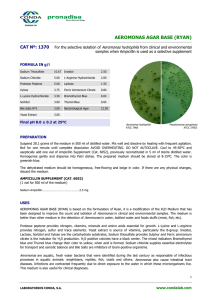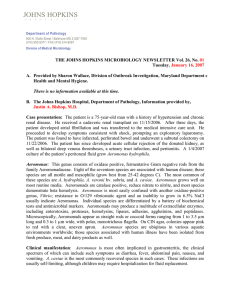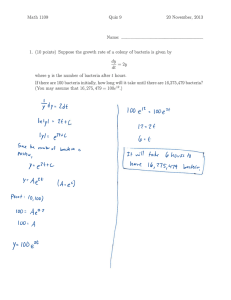The effect of some physical and chemical parameters on growth... aeromonas bacterium, heterotrophic bacteria, total and fecal coli form in

The effect of some physical and chemical parameters on growth of aeromonas bacterium, heterotrophic bacteria, total and fecal coli form in
Isfahan’s Baba sheikh Ali water treatment, Iran
S. Dobaradaran 1, 2 B. Bina 3 B.Nasr Is fahani 3
1 School of Public Health, Bushehr University of Medical sciences, Bushehr,
Iran
2 Department of Environmental Health Engineering, School of Public Health ,
Tehran University of Medical sciences, Tehran, Iran
3
Department of Environmental Health Engineering, School of Public Health ,
Isfahan University of Medical sciences, Isfahan, Iran
Abstract:
Aeromonas is one the gram – negative, non spore – formatting rod shaping, facultative anaerobic and opportunistic bacterium that can cause systematic infections, lesion and diarrhea in human. Fairly high bacterial population in distribution system in not only considerable in respect of affecting consumer health but also it makes difficult to find coliform bacterium indicator. So, the efficiency of Isfahan’s Baba sheikh Ali water treatment plant in removal of
Aeromonas bacterium and Indicator bacteria (heterotrophic bacteria, total and fecal coliform) and the relationship between Aeromonas and heterotrophic bacteria , total and fecal coliform growth with pH, temperature, turbidity, free residual chlorine and Do was measured in this study.
ADA- V media was used in presumptive stage to counting Aeromonas bacterium and after incubation with nutrient agar for a night; oxidase tests, trehalose fermentation and indol test were used in confirmative stage. R
2
A media was used to count HPC bacteria and other factors measured on the basis
1
of standards. The results showed that positive cases of Aeromonas bacteria and increased in higher temperature, turbidity and pH. In contrast, positive cases of
Aeromonas bacteria and HPC decreased while free residual chlorine and Do increased.
Key words : Aeromonas , Baba sheikh Ali water treatment plant, HPC, Isfahan
Introduction
Aeromonas species are bacteria that are gram-negative, non spore-formatting, rod shaped and facultative anaerobes. Although historically the Aeromonas genus has been placed in the family vibrionaccae (Popoff M, 1984). There have been proposals to place it in its own family, the aeromonadacaae
(Colwell RR et al , 1986). The genus includes at least 13 genospecies, among which are the mesophilic A. hydrophila, A. Caviae, A. Sobria, A. Veronii and
A. Schubertii, and the non–motile, psychrophilic A. Solmonicida (WHO,
2002).
A.Salmonicida is a fish pathogen and has not been associated with human infection (Janda JM, Abbott SL, 1996). The mesophilic aeromonads have been commonly isolated from patients with gastroenteritis although their role in causation remains unclear. They are also associated with sepsis and wounds, and with eye, respiratory tract, and other systemic infection (Janda JM, Duffey
PS, 1988). The species principally associated with gastroenteritis are A. cavies
A.
hydrophila , and A. veronii and A. sobria (Joseph sw, 1996). A. caviae is
The health significance of detecting mesophilic aeromonads in public water supplies is not well understood (WHO, 2002) .Reports from Australia have suggested that there may be a connection between cases of Aeromonas associated diarrhea and the number of Aeromonas in the drinking water
(Burke V et al, 1984). The heterotrophic plate count (HPC) represents the
2
aerobic and facultative anaerobic bacteria that derive their carbon and energy from organic compounds. The number of recovered bacteria depends on medium composition, period of incubation (1-7 days), and temperature of incubation (20-35 ْc). This group includes gram- negative bacteria belonging to the following Geneva: Pseudomonas, Aeromonas, Klebsiella,
Flavobacterium, Enterobacter, Citrobacter, Serratia, Acintobacter, Proteus,
Alcaligenes and Moraxella . Some members of this group are opportunistic pathogens (e.g., Aeromonas, Flavobacterium ), but little is known about the effects of high numbers of HPC bacteria on human health. In drinking water, the number of HPC bacteria may vary from< 1 to <10
4
CFU/ml and they are influenced mainly by temperature, presence of a chlorine residual, and level of assimilable organic matter. HPC level should not exceed 500 organisms/ml.
HPC is useful to water treatment plant operators with regard to the following
(AWWA):
1.
Assessing the efficiency of various treatment processes, including disinfection in a water treatment plant.
2.
Monitoring the bacteriological quality of the finished water during storage and distribution.
3.
Determining bacterial growth on surface of materials used in treatment and distribution systems.
4.
Determining the potential for regrowth or aftergrowth in treated water in distribution (Gabriel Bitton, 1999).
Methods and Materials
This study was done in summer in Isfahan’s Baba Sheikh Ali water treatment plant in Iran. For this study 4 stations were selected in Isfahan’s Baba Sheikh
Ali water treatment plant (including station 1: water treatment plant inflow, station 2: primary sedimentation outflow, station 3: filtration outflow, station
4: water treatment plant outflow after disinfection). 13 samples in every station and 52 samples totally were taken.
3
In this study the 1605 method (EPA – Method 1605) was used for a direct counting of Aeromonas species in water based on the growth of yellow colonies on the surface of the membrane filter using a selective medium
(ampicillin dextrin agar with vancomycin) (ADA-V) and incubated at 35 ْ c ±
0.5 ْ c for 24 ± 2 hours, for confirmation the nutrient agar streak plate,
Oxidase confirmation, Trehalose confirmation and Indole confirmation were used. Sampling, sample transmission and Aeromonas colonies counting were done according to standard (EPA, 2001). HPC bacteria detection was done with the use of R
2
A at 35 ْc for 48 hours and according to standard (AWWA,
1992).Temperature with portable thermometer, pH with digital pH meter,
Chlorine with DPD kit, turbidity with HACH 2100 A Turbidimeter and Do with Winkler method were measured.
The results of this study were analyzed with the use of SPSS and Excel
Software and correlation Pearson test and One- way – ANOVA were used in this study.
3- Results and Discussion
The average of measured variables and coefficient values of Pearson correlation were shown in table1 and 2 respectively.
3- 1- pH pH is an important physicochemical water property and one of the most important quality operational parameters of water. pH average of station
1,2,3,4 was 8.1, 7.9, 7.8 and 7.8 respectively (Table 1). With attention to pH values and comparison with different standards, Isfahan’s Baba Sheikh Ali water treatment plant pH was in suitable range for different uses (such as drinking and agricultural). In those stations Pierson correlation test also showed that pH had significant direct relation with number of Aeromonas and
HPC bacteria (P-value <0.01). This relation can not be related to pH effect, because water treatment plant inflow with higher pH passed from different stages (sedimentation with PAC use, filtration with ozonation and disinfection with chlorine) and after those stages water’s pH and number of Aeromona s
4
and HPC bacteria decreased so decrease of water’s pH and numbers of
Aeromonas and HPC bacteria were related to effects of different stages and processes of water treatment plant.
3-2- Temperature
We can’t find standard water temperature values with public health criteria because it does not have any important health effects. American public health,
EPA and WHO do not state any guide values, but EC considered a temperature limit for drinking water between 12 to 25 ْ c. But in general temperature can affect treatment of water source, aqueous life, biochemical reaction rate, drinking water taste, dissolved oxygen, organism activity that produce odour and colour, solubility of solids in water and corrosion rate in distribution system.
With attention to temperature values and comparison with EC standard, we can say temperature values were in suitable range of EC standard (Table 1). In those stations Pearson correlation test also showed that temperature had significant direct relationship, with the number of Aeromonas and HPC bacteria (P-value < 0.01) (Table 2).
Lechevallier et al study in colorinated water also showed that Aeromonas sobria had direct relationship with temperature. (Lechevallier MW, 1982)
(Kay N. Power, Laslo A. Nagy, 1999) (Lechevallier, M, et al, 1987) (Rhodes,
M.W, Kator, H, 1994)
3-3- Turbidity
Turbidity shows the quantity of suspended solids and it is an exceptional parameter and a nonmicrobial parameter with extreme use and it has many uses in general. Turbidity gives many valuable data in all processes and operation of water treatment.
Turbidity is important because of two reasons: 1.It can be a physical parameter that may be objected by consumers 2.It can be a biological parameter that may
5
increase the growth of pathogens and decrease disinfection effectiveness of water.
Maximum permissible turbidity in drinking water is 5NTU and maximum desired turbidity is 1 NTU (Dezuane J, 1997). Average turbidity values at stations 1, 2, 3, 4 were 3.55, 1.08, 0.57 and 0.43 NTU respectively (Table 1).
With attention to Pearson correlation analysis, turbidity had direct significant relationship with number of Aeromonas and HPC bacteria (P-value < 0.01)
(Table 2).
Hass et al study about relationship of microbial parameter in water distribution system with physical and chemical characteristics showed that there was a direct relationship between bacteria growth and turbidity. (Hass, et al, 1983)
3-4- Free residual chlorine
Average free residual chlorine in station 1,2,3,4 was 0, 0, 0 and 0.9 mg/L
(Table 1). Maximum free residual chlorine related to water treatment plant outflow that disinfection with chlorine was done for prevention of regrowth in water distribution system.
With attention to Pearson correlation analysis, free residual chlorine values had reverse significant relationship with number of Aeromonas and HPC bacteria (P-value <0.01) (Table 2).
Previous researches proved this relationship such as Burke et al study for the separation of Aeromonas species from domestic chlorinated drinking water in
Australia and Edge et al study about bacterial regrowth in drinking water distribution system and its relationship with disinfection strategies ( Burke V et al ,1984)( Kay N , et al , 1999)( Holmes P, et al , 1996) (Edge JC, Finch PE
,1987).
3-5- Dissolved Oxygen
Average Do in stations 1,2,3,4 was 7.4, 7.5, 7.8 and 8 mg/L respectively
(Table 1). Station 4 had maximum Do amount and the best microbial quality.
In general, we can say that with the improvement of water microbial respiration and growth of bacteria and consumption of Do decrease. Pearson
6
Correlation analysis showed that Do values in water treatment plant had reverse significant relationship with the number of Aeromonas and HPC bacteria (P-value<0.01) (Table 2). Previous research such as Kaye et al study about regrowh bacterial relation with physical and chemical parameters in drinking water distribution system in Sydney proved this relation ( Kay N , et al , 1999 ).
Conclusion
1.
Maximum number of Aeromonas and HPC bacteria in water treatment inflow samples was 135 CFU/100ml and 380 CFU/ml respectively.
2.
Maximum number of Aeromonas and HPC bacteria in primary sedimentation outflow samples was 55 CFU/100ml and 120 CFU/ml respectively.
3.
Maximum number of Aeromonas and HPC bacteria in filtration outflow samples was 6 CFU/100ml and 8 CFU/ml respectively.
4.
With increasing temperature and turbidity, positive number of
Aeromonas and HPC bacteria decreased.
5.
With increasing free residual chlorine and Do, positive number of
Aeromonas and HPC bacteria decreased.
6.
Efficiency of sedimentation basin with PAC use in removal of
Aeromonas and HPC bacteria was 55% and 61.7% respectively.
7.
Efficiency of sedimentation basin with PAC use plus filtration with ozonation in removal of Aeromonas and HPC bacteria was 96.8% and
97.4% respectively.
8.
Ultimate efficiency of water treatment plant in removal of Aeromonas and HPC bacteria was 100%.
7
Table1. Average measured parameters in sampling stations
Parameter
Station
Cl
2
(mg/L)
Temperature
( ْ C)
Station1
Station2
Station3
Station4
0
0
0
0.9
20.42
20.4
19.63
19.42 pH Do
(mg/L)
Turbidity
(NTU)
Aeromonas
(CFU/100ml)
HPC TC
(CFU/ml) MPN/100 ml
FC
MPN/100 ml
8.09 7.41
7.92 7.56
7.85 7.87
7.82 8.01
3.55
1.08
0.57
0.43
108.23
48.69
3.38
0
188.15 4423.07
72 1411.53
4.92
0
4.53
0
108.61
44.46
1.61
0
Parameter
Aeromonas
HPC
TC
FC
Table 2. Coefficients Pearson Correlation about number of
Aeromonas and HPC bacteria with measured parameters
Cl
2
(mg/L)
-0.512
-0.403
0.424
0.35
Temperature
( ْ C)
0.41
0.425
0.428
0.48
pH
0.824
0.717
0.778
0.526
Do
(mg/L)
-0.366
-0.402
0.434
-0.172
Turbidity
(NTU)
0.961
0.898
0.942
0.656
The Relation is significant at (P-value 0.01) Level
Numbers that shown are coefficients Pearson correlation
Reference:
1.
Popoff M (1984). Genus III Aeromonas Kluyver and van Niel 1936 398
AL . In: Krieg NR, Holt JG, eds, Bergey’s manual of systematic bacteriology, vol.1. Baltimore, MD, Williams of Wilkins: 545-548.
2.
Colwell RR, Macdonell MR, De Ley J (1986). Proposal to recognize the family Aeromans fam.Nov. International Journal of systematic
Bacteriology, 36:437-477.
3.
WHO (2002). Guidelines for drinking water quality, Second edition.
4.
Janda JM, Abbott SL (1996). Human pathogens. In: Austin B et al., eds. The genus Aeromans. London, wiley: 151-173.
5.
Janda JM, Duffey PS (1988). Mesophilic aeromans in human disease:
Current taxonomy, labratory identification, and infectious disease spectrum. Reviews in Infectious Disease, 10: 980-987.
8
6.
Joseph sw (1996). Aeromans gastrointestinal diseases: a case study in causation. In Austin B et al., eds. The genus Aeromans, London, Wiley:
311-355.
7.
Burke V et al (1984). Isolation of Aeromans spp. From an unchlorinated domestic water supply. Applied and environmental
Microbiology, 48:367-370.
8.
Gabriel Bitton (1999). Wastewater Microbiology, John Willy & Sons,
INC Publication, Second edition.
9.
EPA (2001). Method 1605: Aeromans in finished water by membrane filtration using Ampicilin-Dextrin Agar with vancomycin.
10.
APHA, AWWA, WEF (1992). Standard methods for examination of water and wastewater, American Public Health association,
Washington
11.
Lechevallier MW (1982), Aeromans Sorbian in chlorinated drinking water supplies, Microbial ecology, 8:325-794.
12.
Kay N. Power, Laslo A. Nagy (1999), Relationship between bacterial regrowth and some physical and chemical parameters in Sydney’s drinking water distribution system, water Research; Vol 33, 741-750.
13.
Lechevallier, M., Babcock, T.M and Lee, R.G (1987), Examination and charactersation of distribution system biofilm, Appl. Environ microbial, pp.2714-2724.
14.
Rhodes, M.W, Kator, H. (1994), Seasonal Occurrence of mesophilic
Aeromans spp as a function of biotype and water quality in temperate freshwater lakes, water research, Vol: 8, pp 2241 -2251.
15.
Dezuane J (1997), Drinking water quality, 2 nd edition, International
Thomson publishing company, US.
16.
Hass, C.N, Meyer, M. A and Paller, M.S (1983), Microbial alternations in water distribution systems and their relationship to physical- chemical characteristics, AWWA, 75, pp, 475-481.
9
17.
Holmes P, Niccolls LM, Sartory DP (1996), the ecology of mesophilic
Aeromans in the aquatic environment. In: Austin B et al, eds. The genus microbiology, London, Wiley, 127-150.
18.
Edge JC, Finch PE (1987), Observation on bacterial after growth in water supply distribution systems: Implications for distribution for disinfection strategies, Journal of the institute for water and environmental management, 1: 104-110.
10



